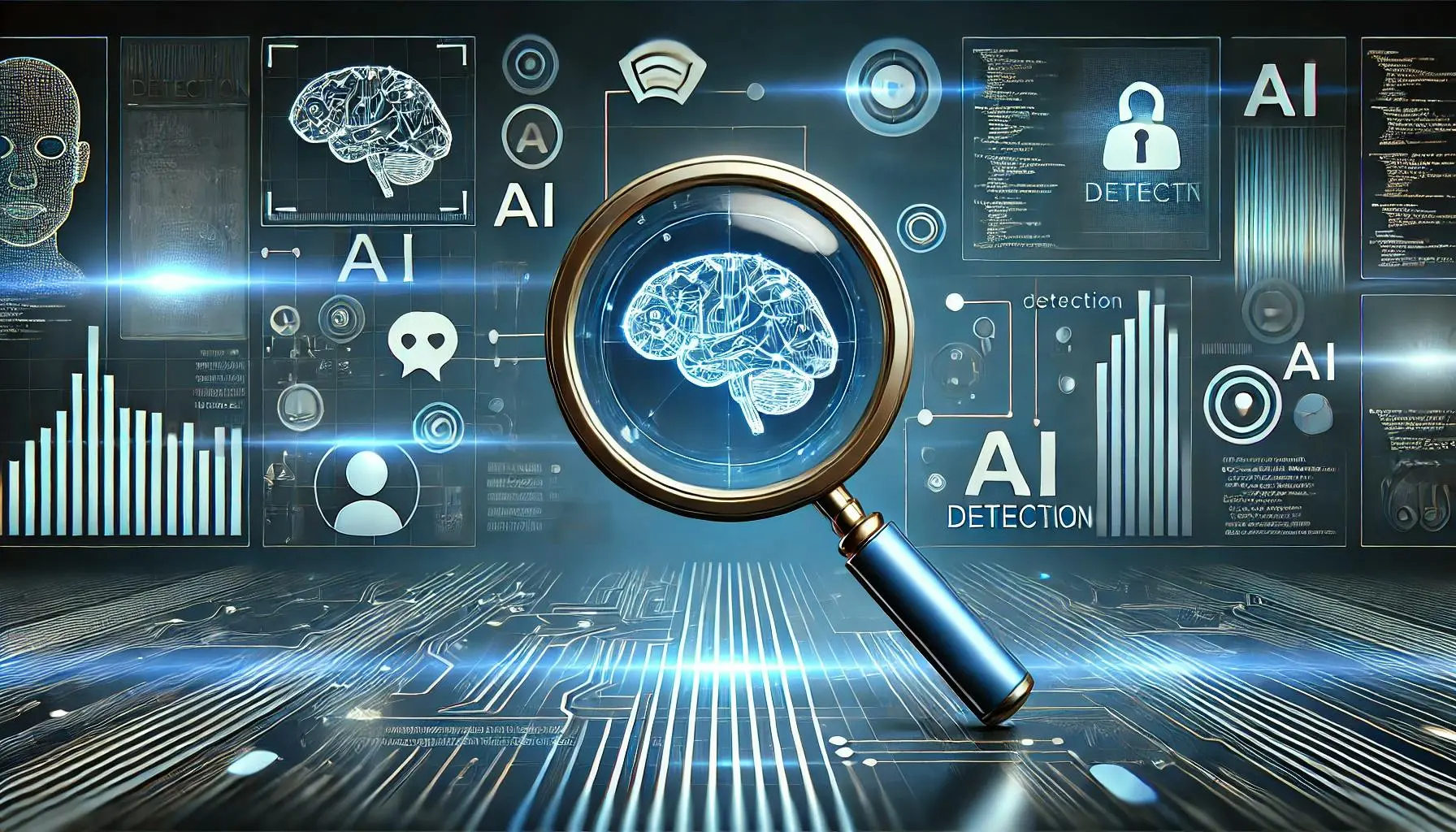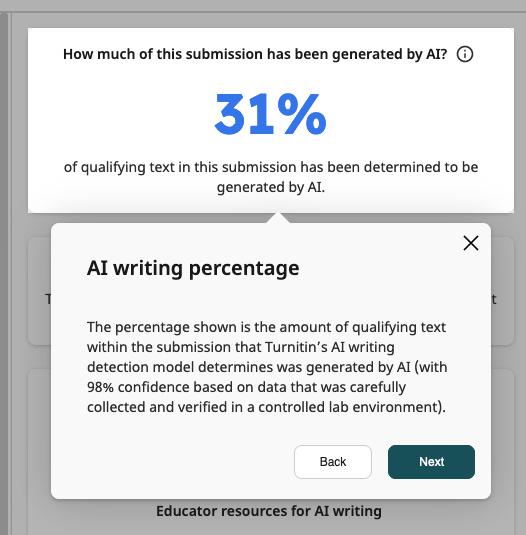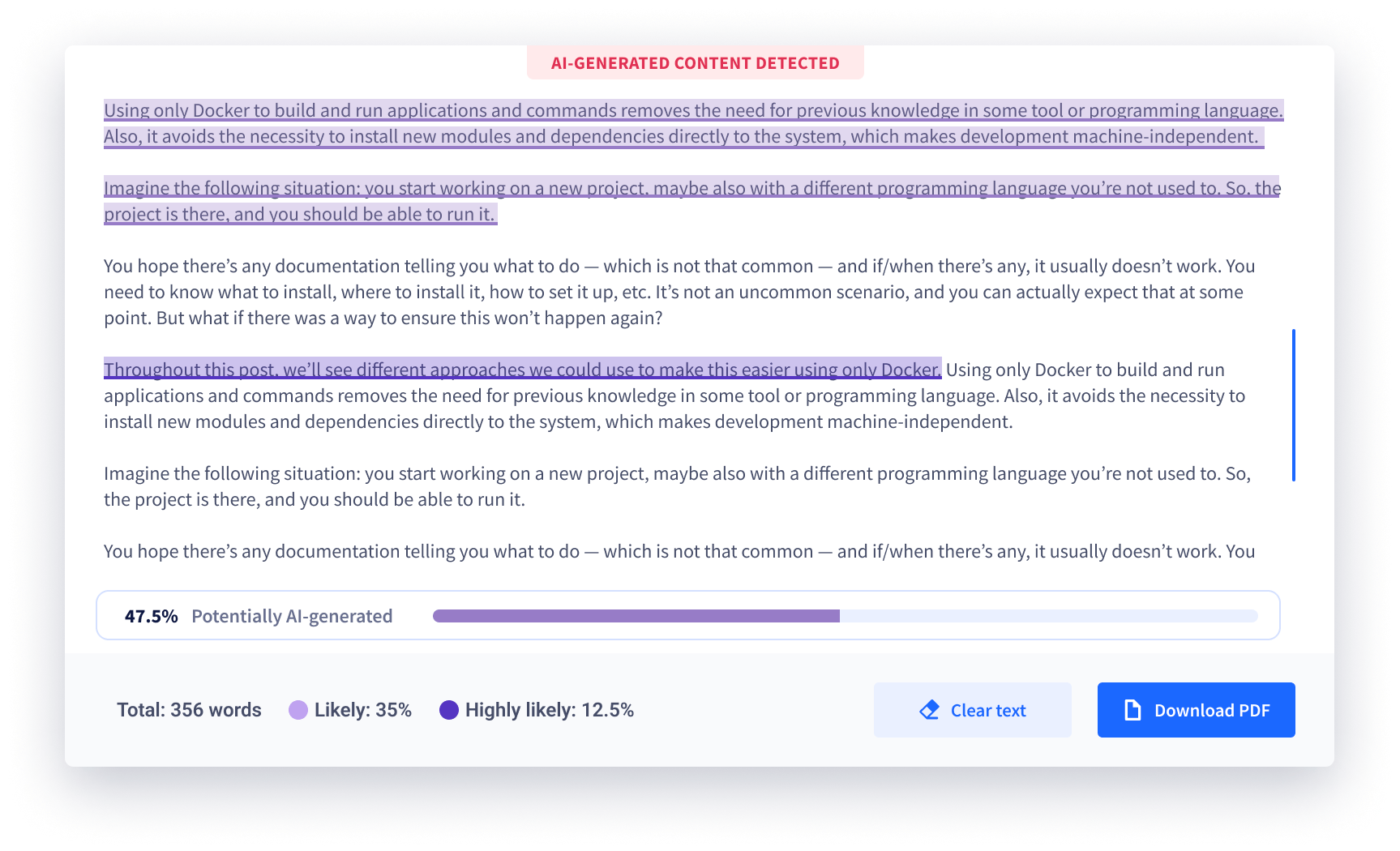
Turnitin is one of the essential tools in any academic sphere of the world. It is important in identifying plagiarism as well as AI content. As generative AI tools, such as ChatGPT, become popular, people have started questioning Turnitin and its ability to detect AI-generated text. Let's discuss what AI can detect when it enters Turnitin, its reliability in identifying AI writing, and the technologies that make that possible
Also read How AI Detectors Work to Spot AI-Generated Text and Content.
How accurate is Turnitin at detecting AI content?
Turnitin can identify a majority of artificial intelligence-generated work at a very high degree of accuracy, particularly where all of the written text is being generated by AI. Based on new statistics, the detection rate of Turnitin regarding the common text AI is 98-100% accurate. It applies more powerful machine learning algorithms, such as stylometric analysis and machine learning classifiers, to detect writing patterns outside that of humans. Nevertheless, its accuracy is low in cases where the content has been paraphrased or edited by a human, for example
-
Detection accuracy for hybrid content (AI + human): 60–80%
-
Detection accuracy for paraphrased AI content: 40–70%
These statistics depict that although Turnitin will be very dependable in predicting raw AI texts, it has lower proficiency in detecting elaborate human-AI editing.
Also, read on how to bypass Character AI Filter 2025
Turnitin's detection process explained
Turnitin has AI detection as part of its submission process. All of the documents uploaded undergo plagiarism scanning and artificial intelligence content analysis. It resorts to such features as:
Lexical diversity
Syntactic complexity
Perplexity and burstiness
Sentence predictability
These metrics aid in the distinction of human and machine writing. An example can be given when AI-written text tends to use the same number of sentences and words at a similar rate as opposed to human writing, which shows more variety. The 31 linguistic features are assessed with a stylometric analysis, which means the mechanism can detect the slightest indicators of the involvement of an AI. Perplexity is a measure of context predictability of words, whereas burstiness estimates sentence variance.

Real-world data on detection accuracy
Here is a breakdown of key performance metrics for Turnitin’s AI detection system in 2025:
|
Metric |
Value |
|
Number of writing samples tested |
805 |
|
Mean accuracy rate (non-manipulated AI texts) |
39.5% |
|
Accuracy rate (after adversarial manipulation) |
22.1% |
|
False accusation rate (human flagged as AI) |
15% |
A bar chart comparing sample counts and detection accuracy shows Turnitin's strengths and weaknesses. The system performs best on unedited AI texts but struggles with hybrid or paraphrased content.

Also, read on how Character AI 2025 transforms conversations with custom bots
AI Models Detected by Turnitin
Turnitin has shown strong performance against leading AI models:
|
AI Model |
Detection Accuracy |
Notes |
|
GPT-3 |
99.95 |
Highest accuracy due to model familiarity |
|
GPT-3.5 |
99.65% |
Slightly better composition, still detectable |
|
ChatGPT |
98.65% |
More human-like, slightly lowers accuracy |
Even though these detection rates are high, the use of personas or conversational prompts can lower scores. This emphasises the need for human oversight.
How Turnitin Flags AI Content
Turnitin’s AI Writing Indicator divides flagged content into:
-
AI-generated only (cyan)
-
AI-paraphrased (purple)
It displays a submission bar to show the proportion of AI-generated text. Scores below 20% are shown as an asterisk, which reduces false accusations. Scores above 20% appear as percentages.

|
Feature |
Description |
|
False positive rate |
Less than 1% |
|
Minimum text length |
300 words |
|
Percentage display threshold |
Only shown for scores over 20% |
|
Color Coding |
Cyan (AI-written), Purple (AI-paraphrased) |
|
AI paraphrasing detection |
Included to catch reworded AI content |
Impact on students and educators
An international survey indicates that there is 73.6 per cent of students use AI tools to write and edit. Due to such general use, the idea of solid AI detection systems is gaining currency. Educators are, however, adjusting to the trends. In 2025, approximately 68 per cent of teachers say that they use AI detection tools. Also, the percentage of disciplinary actions on AI misconduct increased by 64 per cent to 48 per cent. These figures also show how useful tools such as Turnitin are when it comes to enforcing academic standards. Nevertheless, with the increased application of AI detection methods, the concept of fairness is also affected. Because of false positives, i.e. the unfounded detection of cases when the generated text has been produced by a person, students may suffer significant consequences. To prevent such problems, the teachers are advised to combine the results found by Turnitin with their knowledge of the different writing styles of their students, the types of assignments, and other writing samples in their possession.
Also read how Janitor AI 2025 empowers users with unfiltered chatbot creation.
Strengths and weaknesses of Turnitin's AI detection
Strengths
-
Full AI text with high accuracy
-
Real-time analysis of plagiarism and AI
-
Contribution of better algorithms through iThenticate 2.0
Limitations
-
Reduced accuracy of hybrid or paraphrased texts
-
Inability to work with non-sentence structures, such as lists or bullet points
-
It is possible to have false positives, but such cases are not frequent
Turnitin is not very aggressive in detection. It ensures stocking the number of false positives, at the expense of missing up to 15 per cent of AI content.
Key statistics and 2025 updates
In 2025, more than 9.9 million papers submitted to Turnitin had more than 80 per cent AI-generated text. Standard AI pulls off a detection accuracy of 98 to 100 per cent in detecting text. But when it comes to hybrid-type content, that is, when hybrid content is mixed with AI-written content and human-written content, the detection accuracy is reduced to anything between 60 and 80 per cent. AIs with paraphrased content are even more difficult to detect, and that includes accuracy levels of 40-70%.
The 50% score on AI is now being used in many academic institutions as one measure to call into investigations possible cases of academic misconduct. With increased utilisation of AI, the figure of educators who have used AI detection tools rises to 60%, and the percentage of students is even higher, standing at 61% who have used AI in their studying discipline. Integration of AI into the academic systems has also provided up to 70 per cent teachers' workload reduction particularly in grading and planning.
Turnitin also implemented some updates to become more accurate and scalable in 2025. Among them, there is the ability to detect AI-paraphrased text, additional support for longer submissions (as much as 30,000 words), and improved visual reports and administrative analytics. These improvements enable the institutions to keep track of AI use trends and detect and evaluate the detection scores more effectively, with no compromise on the integrity.
Responsible use of Turnitin AI detection
Turnitin is keen on highlighting that AI detection does not mean to eliminate human judgment. Teachers should take teaching guides as an AI Writing Indicator to be used in the initiation of discussion, though not as conclusive information. A comparison of the results of AI detection with past student work, knowing the task type, and the needs of individual students, will help with the objective and correct review. There should be detection scores that will act as tools of investigation to discuss academic integrity. The spirit behind the responsible application of Turnitin helps encourage an equal balance between technology and educator intuition.
FAQS: Turnitin AI detection
Will Turnitin tell you if it detects AI?
Will the AI Report tell me which AI tools or AI websites have been used? At this time, the AI Report will only inform you of the percentage of the assignment that it believes has been generated by AI, as well as which parts of the assignment have been flagged in the AI detection process.
How much AI detection is acceptable on Turnitin?
To avoid potential incidence of false positives, no score or highlights are attributed for AI detection scores in the 1% to 19% range. When AI is detected below the 20% threshold in the report, it is now indicated with an asterisk (*%), and no percentage is attributed.
How to avoid AI detection on Turnitin?
If you need assurance that your paper can bypass Turnitin AI detection while maintaining originality, visit Coursepivot for expert assistance.
Rewrite AI-Generated Text in Your Own Words. ...
Avoid Overuse of Formal and Robotic Language. ...
Incorporate Personal Insights and Reflections. ...
Break Up Long Sentences
Does Turnitin detect AI 2025?
Does Turnitin Detect ChatGPT? A Comprehensive Guide to AI ...
By 2025, Turnitin will have become a key player in supporting academic integrity, offering institutions tools to detect AI-generated content effectively. Paired with platforms like Detecting-AI.com, which provides additional verification options, these tools create a solid system for upholding academic standards
Can Turnitin detect AI if I paraphrase?
Can Turnitin detect paraphrasing? Yes, it can. Turnitin can identify paraphrased plagiarism, even if it is done by paraphrasing tools like QuillBot. It can also detect paraphrased AI content.